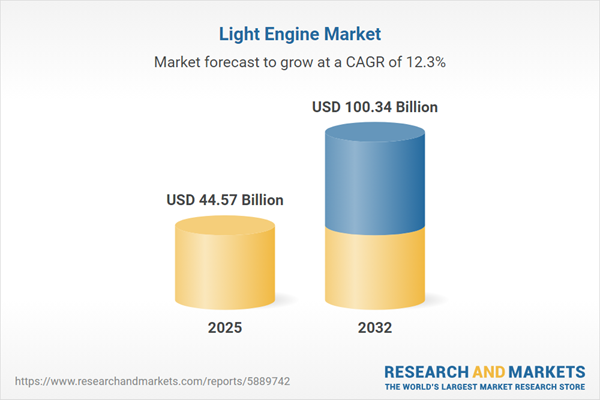Speak directly to the analyst to clarify any post sales queries you may have.
The global light engine market is advancing rapidly, driven by increasing demand for high-performance and energy-efficient lighting solutions across diverse industries. As innovative technologies and evolving regulations redefine market dynamics, stakeholders face new challenges and opportunities in optimizing their strategies for growth, supply chain resilience, and sustainability.
Light Engine Market Snapshot
The light engine market grew from USD 39.58 billion in 2024 to USD 44.57 billion in 2025 and is forecasted to continue its strong expansion at a CAGR of 12.33%, reaching USD 100.34 billion by 2032. This growth reflects robust investments in advanced lighting systems and a pronounced shift toward energy efficiency, intelligent controls, and integrated modules. Companies operating in this space are leveraging new semiconductor materials, adaptive control solutions, and enhanced system design, impacting a range of end-use sectors such as automotive, commercial, industrial, residential, and entertainment applications.
Scope & Segmentation
- Technology Types: Laser (RGB laser, single color laser), LED (chip-on-board (COB) module, surface mount device (SMD) module)
- Application Areas: Automotive (exterior lights, headlamps, interior lights), Commercial (hospitality, offices, retail), Entertainment (architectural facade, stage lighting), Industrial (manufacturing, warehouse), Residential (indoor, outdoor)
- Distribution Channels: Aftermarket (direct end users, distributors), OEM (tier 1 OEM, tier 2 OEM), Offline retail (mass merchandisers, specialty stores), Online retail (ecommerce platforms, manufacturer websites)
- Price Ranges: High end, Mid range, Low end
- Regions Covered: Americas (North America, Latin America), Europe, Middle East & Africa, Asia-Pacific
- Key Market Players: Signify N.V., OSRAM GmbH, Lumileds LLC, Cree, Inc., Nichia Corporation, Samsung Electronics Co., Ltd., Seoul Semiconductor Co., Ltd., Bridgelux Inc., Everlight Electronics Co., Ltd., Epistar Corporation
Key Takeaways
- Advancements in semiconductor materials and new packaging technologies are enabling precise color rendering and increased luminous efficacy, addressing the needs of automotive and architectural sectors.
- Regulatory frameworks centered on energy consumption and environmental responsibility are guiding product development and encouraging collaborations and acquisitions among manufacturers, optics specialists, and software providers.
- Integration of intelligent control systems and IoT connectivity is transforming traditional luminaires into adaptive, data-driven lighting engines, enabling predictive maintenance and stronger operational efficiency.
- Market response to supply chain disruptions and macroeconomic pressures has included nearshoring, diversification of supplier networks, and an increased focus on modularity and standardization to support customized, scalable solutions.
- Collaboration with regional partners and targeted investment in next-generation materials have emerged as key differentiators for companies aiming to optimize cost structures and navigate complex procurement environments.
- Greater emphasis on sustainability and circular economy principles is reshaping both product portfolios and manufacturing processes, responding to increasing demand for environmentally conscious lighting options.
Tariff Impact on Supply Chain and Competitiveness
The introduction of tariffs on imported lighting components in 2025 has prompted supply chain realignment, with a shift toward regional sourcing and domestic manufacturing to counteract increased costs. Strategic investments in localized production, as well as research into alternative materials, are driving operational efficiencies and margin resilience. These changes have enabled agile manufacturers to capture market share and compelled larger organizations to renegotiate supplier agreements and pursue vertical integration for sustained competitiveness.
Methodology & Data Sources
This report utilizes a combination of primary and secondary research methods. Insights were gathered from stakeholder interviews, quantitative surveys, and analysis of technical standards, trade publications, and industry white papers. Data segmentation covers technology types, applications, distribution channels, and regional trends, ensuring rigorous triangulation and transparency throughout the research process.
Why This Report Matters
- Empowers senior decision-makers to anticipate and respond to regulatory shifts, tariff changes, and evolving supply chain realities within the light engine market.
- Enables identification of growth opportunities by clearly mapping technology advancements, end-use trends, and competitive strategies relevant to both global and regional operations.
- Supports strategic planning through comprehensive segmentation analysis, actionable recommendations, and insight into key players and emerging collaborations.
Conclusion
Continuous innovation in technology, regulation, and supply chain design is transforming the light engine market landscape. With a focus on resilience, collaboration, and sustainability, organizations can position themselves for long-term competitiveness and capitalize on evolving market opportunities.
Additional Product Information:
- Purchase of this report includes 1 year online access with quarterly updates.
- This report can be updated on request. Please contact our Customer Experience team using the Ask a Question widget on our website.
Table of Contents
3. Executive Summary
4. Market Overview
7. Cumulative Impact of Artificial Intelligence 2025
Companies Mentioned
The companies profiled in this Light Engine market report include:- Signify N.V.
- OSRAM GmbH
- Lumileds LLC
- Cree, Inc.
- Nichia Corporation
- Samsung Electronics Co., Ltd.
- Seoul Semiconductor Co., Ltd.
- Bridgelux Inc.
- Everlight Electronics Co., Ltd.
- Epistar Corporation
Table Information
| Report Attribute | Details |
|---|---|
| No. of Pages | 186 |
| Published | October 2025 |
| Forecast Period | 2025 - 2032 |
| Estimated Market Value ( USD | $ 44.57 Billion |
| Forecasted Market Value ( USD | $ 100.34 Billion |
| Compound Annual Growth Rate | 12.3% |
| Regions Covered | Global |
| No. of Companies Mentioned | 11 |









